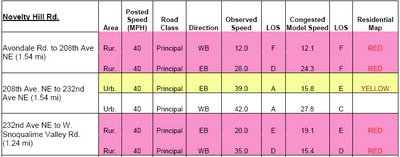Among the findings made by Tom Noguchi of Mirai Transportation and Planning were the following, based on two of the questions asked by the King County Council in 2004 to be answered by the audit:
Is the concurrency model documented and consistent with best practices?
Answer: "No, we found many problems.
- Concurrency models overly complex
- Quality control is poor
- Many technical assumptions have not been documented and presented to Council
- Modeling techniques are not consistent with standard practices and do not reflect driver behaviors
- Traffic congestion as measured by the model was significantly reduced in 2004 - not true based on our experience
- Road Services staff could not explain the reason for this change"
Does King County's base transportation model used for transportation planning employ best practices for transportation modeling?
Answer: "Yes, it is generally sound"
The "base transportation model" is created by the Transportation Forecast Data Management group (TFDM). The Concurrency Group then takes this base model and modifies it to reflect current and future development and road projects before determining whether a new development application meets concurrency or not. A development application cannot even be considered unless it has obtained a concurrency certificate issued by the concurrency group, so the importance of the concurrency group's modeling methods and integrity, in support of county standards, is of paramount importance.
As a result of a concurrency certificate issued to Weyerhaeuser in 2002 for Redmond Ridge East, and after all their efforts had failed to have their concerns addressed within KCDOT, five (5) employees within the KCDOT TFDM group, including its supervisor, filed a whistleblower complaint in 2003 alleging improper and possible illegal acts committed by the Concurrency Group to help Weyerhaeuser improperly obtain that Redmond Ridge East traffic concurrency certificate. They have since filed, and the case is currently pending, a lawsuit in Federal Court alleging, among other things, retaliation by their management and DOT Director Linda Doherty, because they would not go along with what they believed were indefensible actions and decisions being made in support of Redmond Ridge East.
The TFDM's allegations were affirmed in 2005 when King County Hearing Examiner Stafford Smith ruled that the concurrency group had engaged in at least 3 instances of "arbitrary and capricious" actions that helped Redmond Ridge East, but that could not be adequately explained or justified. Smith's recommendation to the County Council as a result of the Redmond Ridge East hearings was to deny Redmond Ridge East and to rescind the traffic concurrency certificate issued in 2002.
The table below shows the current status of Novelty Hill Road with hundreds of homes yet to be constructed in Trilogy and before approval of Redmond Ridge East. With an average westbound speed of just 12 mph and a LOS F score (for Failing), what this shows is King County's determination to not let anything deter it from helping Quadrant/Weyerhaeuser. With Novelty Hill Road RED and failing both east and west of Redmond Ridge and Trilogy, can anyone defend KCDOT's claims that 800 more homes can be supported?

Redmond Ridge East is an 800-home development under Council consideration today adjacent to the eastern boundary of Redmond Ridge. With the only citizen opposition group, Friends of the Law, settling with Quadrant after the appeal window had closed, the King County Council appears ready to forgive all the wrongdoing and allow Redmond Ridge East to move forward in phases, again awarding Quadrant the ability to construct hundreds of additional homes before critical road infrastructure is planned, studied, funded or approved.
The auditor's findings support allegations made by citizens opposing Redmond Ridge, Trilogy, and now Redmond Ridge East going back a decade. Those charges have consistently alleged that the DOT concurrency group has been "cooking the books" to assist Quadrant Homes win approval of massive developments, without the concurrency group identifying the adverse impacts, or Quadrant funding the necessary road improvements within King County, surrounding cities, or to state-funded highways.
As usual, King County is interested in only looking forward. The Council's plan for Redmond Ridge East, presented by Dow Constantine in the appeal hearing last month, again makes empty promises to fix the traffic mess along Novelty Hill and Avondale roads. It awards Quadrant with hundreds of additional permits for doing virtually nothing and before any of the needed improvements to Novelty Hill Road have even been approved. It also ignores the "arbitrary and capricious" actions committed by county planners and their management whose acts have allowed an application to be considered that should never have received a concurrency certificate in the first place.
The presentation can be viewed at about 1 hour 11 minutes into the following archived video:
rtsp://media01.metrokc.gov:554/CouncilArchive/cow/COW20060710.rm
Or at http://www.metrokc.gov/CTV/Archive/index.htm
Scroll down to "Committee of the Whole" on the main page and click the link for July 10, 2006. Again, the audit preseentation starts at about 1 hour 11 minutes into the video
If you're intereseted in the Audit Presentation Click Here
If you're interested in the Detailed Audit Report Click Here
No comments:
Post a Comment